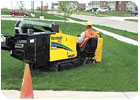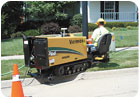
The directional drilling market is back on the rise.
The horizontal directional drilling (HDD) market definitely has rebounded from the devastating dive it took more than five years ago when jobs calling for the installation of cross-country fiber optic lines came to an abrupt halt. Recently emerging from that era has been an increase in the number of fiber-to-the-premises jobs, which has sent more contractors out looking for compact HDD machines.
Sales of compact HDD machines have increased over the past two years, and industry watchers say they expect that trend to continue as more municipalities focus on improving their infrastructures.
Defining a Compact Rig
When performing service drops to a home or small business, there are several reasons contractors and municipalities might opt to use a compact HDD machine. Oftentimes, however, the driving force behind their decision is customer demand for installation methods that cause minimal disturbance to lawns, driveways, sidewalks, highways and other established structures.Compact HDD machines also have productivity advantages. In general, an HDD unit with up to 10,000-pounds of pullback can complete bores out to 300 feet, thus enabling contractors to complete more service drops in less time.
So how do you know what’s considered a compact HDD machine? Since the beginning of their creation, HDD machines have been rated by their pullback specification. Generally, most manufacturers place machines with up to 16,000-pounds of pullback in the compact HDD category.
When looking to purchase a compact HDD, contractors should first evaluate the type of work they will be performing. In addition to fiber-to-the-premises work, compact HDD machines can also be used to install water, gas services and electric lines, and other utilities from the curb to a house or small business. Contractors should consider the length of bores, size of utility lines, and the types of areas and ground conditions in which they will be using the machine.
Once all of these factors have been determined, contractors should purchase a compact HDD machine that has the most pullback and rotational torque, largest water capabilities in the smallest footprint, and the longest drill stem in its class.
Buying a machine with a small footprint can give contractors a competitive edge. If a compact HDD machine can pack more power in a smaller package, it enables utility contractors better access to confined spaces and improved maneuverability within those areas. On a job site, you often need to back the rig up against a building to start the bore or work in confined spaces. So the shorter the machine, the better you can get situated and begin working. Having a machine that can easily be packed up and transported to the next job site is key. All that’s needed to transport most compact HDD rigs is a 1-ton pickup truck.
Lower operating costs are another benefit compact directional drills provide. Due to their size, the compact machines burn less fuel and use less expensive drill pipes and downhole tools.

This rig’s footprint is 35.5 inches wide by 115 inches long.
New Features Help Increase Efficiency
In order for compact HDD machines to keep up with market demands, manufacturers are discovering new ways to improve the machines.One feature that recently has appeared in the compact directional drill market is the rack-and-pinion carriage drive, which is designed to provide high performance on a range of mid- to large-size directional drilling projects. In addition to providing smooth and powerful operation, the rack-and-pinion carriage drive eliminates maintenance of chains.
Over the years, HDD manufacturers also have focused on improving the reliability of the machines’ hydraulic and electronic components. Special attention has been paid to the vices that clamp and break apart the drill rods because if you can’t break apart your drill stem, you’re not going to bore very far.
In striving to provide the most power and productivity in the smallest package, some manufacturers are increasing the length of drill stem a compact HDD rig is capable of carrying. A longer drill stem reduces the number of times the operator has to make and break joints during a bore.
An increasing number of compact HDD manufacturers have turned to improving operator comfort as a way to improve operator efficiency. For some manufacturers, accomplishing this has meant revamping operator controls and integrating them into joystick controls so that operators don’t have to search for additional buttons or switches.
What Lies Ahead
Though the telecommunications boom took a dive in 2001, the recent fiber-to-the premises installation surge continues to provide work for many contractors specializing in HDD. An increase in water, sewer, gas and electrical service installation jobs also has played a role in the market’s upswing. As cities grow and municipality infrastructures age, there’s an opportunity for compact HDD machines to make a significant impact on the installation of the services that residents need and demand.ND
Report Abusive Comment